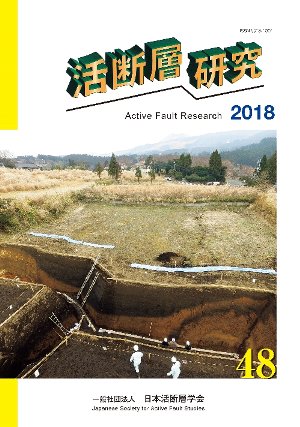
- 49 号 p. 1-
- 48 号 p. 1-
- |<
- <
- 1
- >
- >|
-
山口 勝2018 年 2018 巻 48 号 p. 1-11
発行日: 2018/03/31
公開日: 2018/12/27
ジャーナル フリーThis study clarifies the fact that 8K technology is useful for not only broadcasting but also disaster research especially for active fault research in terms of remote sensing and space information. We define that “8K” is image sensor for saving lives. NHK used an 8K small camera in aerial filming of areas along active faults immediately after the 2016 Kumamoto earthquake. As we analyze the 8K videos, undiscovered earthquake faults and ruptures were found, which were reported in NHK’s TV programs. This served as the first utilization of disaster analyses of 8K images. Remarkable features of 8K aerial filming as below.
1: We discovered surface ruptures and displacements as small as a few centimeters and fault in the forest from an altitude of 400 meters. “High ground resolution” is 5mm that is 20 times higher than aerial photography of Geospatial Information Authority of Japan.
2: The angles of view of 8K is 4 times wider than 4K and 16 times wider than 2K(HD). Useful for following the continuity and distribution of faults and ruptures.
3: Since ruptures may cause a variety of disasters, there are high expectations for the utilization of 8K images in disaster risk reduction and disaster science.
4: “8K’s oblique bird’s-eye views” provides vertical information that will make it easier to survey collapsed buildings, and its graphics data can be utilized for making “3D models”.
抄録全体を表示PDF形式でダウンロード (1468K) -
―変動地形学的意義と建物被害への影響鈴木 康弘, 渡辺 満久, 中田 高2018 年 2018 巻 48 号 p. 13-34
発行日: 2018/03/31
公開日: 2018/12/27
ジャーナル フリーThe 2016 Kumamoto earthquake occurred due to reactivation of active faults, causing severe damage along the faults. Earthquake faults clearly appeared on the ground surface not only along well-known Futagawa-Hinagu active fault, but also in the urbanized area of Mashiki town where no active fault was previously identified. It is essential for earthquake disaster prevention to clarify the details of this unknown earthquake fault and to consider the relationship with the damage. This paper clarifies the distribution of earthquake faults in Mashiki town, discusses the relationship between earthquake faults and tectonic landforms, and then compares the distribution of earthquake faults with the data of previous studies on building damage to examine the relationship between surface faulting and building damage. We concluded that (1) earthquake faults are clearly continuous for about 5 km from the main trace of Futagawa fault to the urbanized area, (2) the fault diverges from the east to the west, and displacement amount of about 70 cm is maintained even at the western end, (3) the earthquake faults are located along the tectonic landforms which were newly identified in the urbanized area of Mashiki, (4) the lateral average slip rate of the active faults in the town is possibly estimated more than 1.8 mm/year, (5) the recurrence interval could be calculated less than a thousand year if the 2016 activity is characteristic for the fault, (6) building damage tends to be severe near the fault where displacement amount exceeds 10 cm.
抄録全体を表示PDF形式でダウンロード (4793K) -
佐々木 亮道, 小坂 英輝, 三輪 敦志, 阿部 恒平, 立石 良, 鎌滝 孝信, 楮原 京子, 今泉 俊文2018 年 2018 巻 48 号 p. 35-47
発行日: 2018/03/31
公開日: 2018/12/27
ジャーナル フリーWe describe the distribution and Holocene activity of the Nikaho active fault zone based on geomorphic features and surface geology. We performed aerial photo interpretation, drilling surveys of the sediments composing the topographic surfaces using soil auger and driven type core sampler, drew topographic profiles of the deformed terraces, and performed analysis of boring data by public works in the study area. This fault zone is composed of the Iseiji fault, the Ishida fault, and the Koide fault distributed in the western part of the Nikao hills, trending NNE to SSE with a length of about 11 km. Based on the displacement of the topographic surfaces and chronology of the sediments composing the topographic surfaces, the average vertical slip rate and the amount of displacement accompanying an earthquake are estimated to be 1.3-1.8m/ky, and c.a.2-3m, respectively. We estimated that the latest faulting event of the active fault zone occurred after c.a. 600 cal.y.B.P. and the average recurrence interval of the active fault zone is about 1,400-1,900 years. In addition, this fault zone is presumed to extend more than 15 km to the northern sea area.
抄録全体を表示PDF形式でダウンロード (2485K)
- |<
- <
- 1
- >
- >|